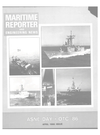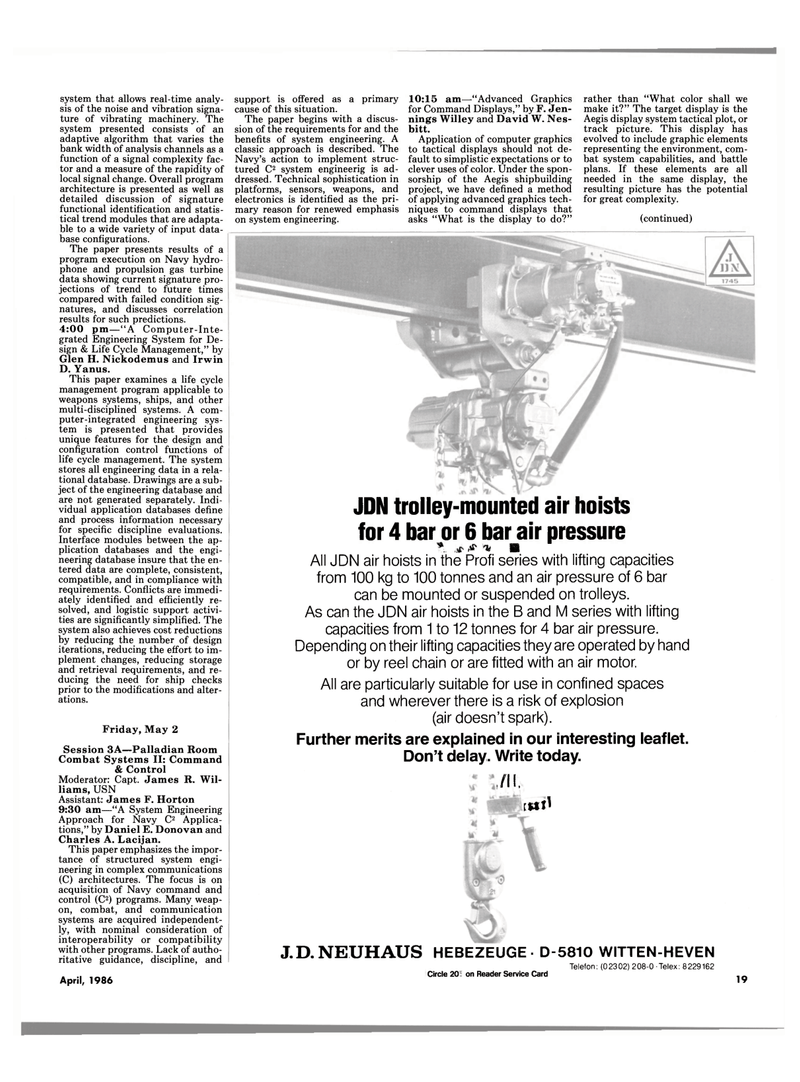
Page 15: of Maritime Reporter Magazine (April 1986)
Read this page in Pdf, Flash or Html5 edition of April 1986 Maritime Reporter Magazine
system that allows real-time analy- sis of the noise and vibration signa- ture of vibrating machinery. The system presented consists of an adaptive algorithm that varies the bank width of analysis channels as a function of a signal complexity fac- tor and a measure of the rapidity of local signal change. Overall program architecture is presented as well as detailed discussion of signature functional identification and statis- tical trend modules that are adapta- ble to a wide variety of input data- base configurations.
The paper presents results of a program execution on Navy hydro- phone and propulsion gas turbine data showing current signature pro- jections of trend to future times compared with failed condition sig- natures, and discusses correlation results for such predictions. 4:00 pm—"A Computer-Inte- grated Engineering System for De- sign & Life Cycle Management," by
Glen H. Nickodemus and Irwin
D. Yanus.
This paper examines a life cycle management program applicable to weapons systems, ships, and other multi-disciplined systems. A com- puter-integrated engineering sys- tem is presented that provides unique features for the design and configuration control functions of life cycle management. The system stores all engineering data in a rela- tional database. Drawings are a sub- ject of the engineering database and are not generated separately. Indi- vidual application databases define and process information necessary for specific discipline evaluations.
Interface modules between the ap- plication databases and the engi- neering database insure that the en- tered data are complete, consistent, compatible, and in compliance with requirements. Conflicts are immedi- ately identified and efficiently re- solved, and logistic support activi- ties are significantly simplified. The system also achieves cost reductions by reducing the number of design iterations, reducing the effort to im- plement changes, reducing storage and retrieval requirements, and re- ducing the need for ship checks prior to the modifications and alter- ations.
Friday, May 2
Session 3A—Palladian Room
Combat Systems II: Command & Control
Moderator: Capt. James R. Wil- liams, USN
Assistant: James F. Horton 9:30 am—"A System Engineering
Approach for Navy C2 Applica- tions," by Daniel E. Donovan and
Charles A. Lacijan.
This paper emphasizes the impor- tance of structured system engi- neering in complex communications (C) architectures. The focus is on acquisition of Navy command and control (C2) programs. Many weap- on, combat, and communication systems are acquired independent- ly, with nominal consideration of interoperability or compatibility with other programs. Lack of autho- ritative guidance, discipline, and
April, 1986 support is offered as a primary cause of this situation.
The paper begins with a discus- sion of the requirements for and the benefits of system engineering. A classic approach is described. The
Navy's action to implement struc- tured C2 system engineerig is ad- dressed. Technical sophistication in platforms, sensors, weapons, and electronics is identified as the pri- mary reason for renewed emphasis on system engineering. 10:15 am—"Advanced Graphics for Command Displays," by F. Jen- nings Willey and David W. Nes- bitt.
Application of computer graphics to tactical displays should not de- fault to simplistic expectations or to clever uses of color. Under the spon- sorship of the Aegis shipbuilding project, we have defined a method of applying advanced graphics tech- niques to command displays that asks "What is the display to do?" rather than "What color shall we make it?" The target display is the
Aegis display system tactical plot, or track picture. This display has evolved to include graphic elements representing the environment, com- bat system capabilities, and battle plans. If these elements are all needed in the same display, the resulting picture has the potential for great complexity. (continued)
JDN trolley-mounted air hoists for 4 bar or 6 bar air pressure * * & % m
All JDN air hoists in the Profi series with lifting capacities from 100 kg to 100 tonnes and an air pressure of 6 bar can be mounted or suspended on trolleys.
As can the JDN air hoists in the B and M series with lifting capacities from 1 to 12 tonnes for 4 bar air pressure.
Depending on their lifting capacities they are operated by hand or by reel chain or are fitted with an air motor.
All are particularly suitable for use in confined spaces and wherever there is a risk of explosion (air doesn't spark).
Further merits are explained in our interesting leaflet.
Don't delay. Write today. ,/n. tat*
J.D.NEUHAUS HEBEZEUGE- D-5810 WITTEN-HEVEN
Telefon: (02302) 208-0-Telex: 8229162
Circle 201 on Reader Service Card 19

 14
14

 16
16
